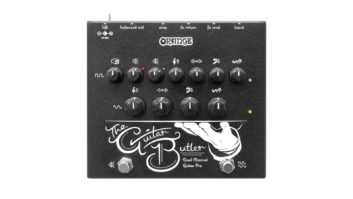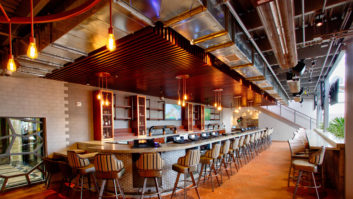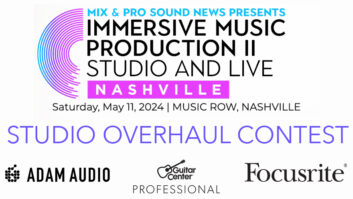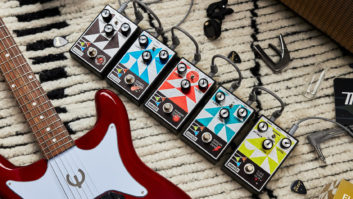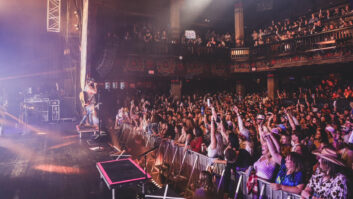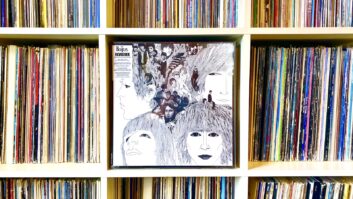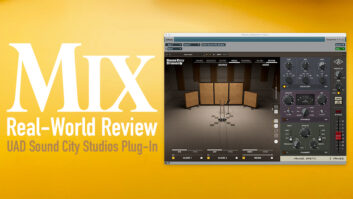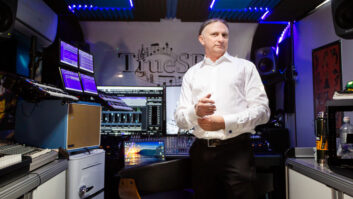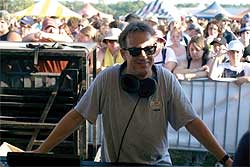
Pete Keppler
The sheer number of different amps, amp simulators, direct-input systems and acoustic pickups on the market today for guitar is pretty staggering—probably not that far from the number of musicians who are out there actually plugging into it all. In the world of guitar amps alone, dozens of boutique companies have sprung up in the past 10 to 20 years, not to mention the major manufacturers that keep cranking out new models every year and bringing out various re-issues of their classic amps from the 1950s, ’60s and ’70s. With so much gear out there, the quest for a killer guitar tone in your live mix may seem a little daunting. It will take a bit of experimentation, but assuming your player has settled on a rig that they’re comfortable with onstage, it’s relatively easy to zero in on your options and make a choice for the best method of capturing that sound.
When selecting mics for a guitar amp, a good first step is just to listen. Because much of the sound from any non-synthetic instrument is shaped by the player’s style and technique, try to get the actual player (not their tech or other substitute) to play through the entire rig, including wireless systems, pedals and all lengths of cable being used. Make a mental note of the overall sound of the rig, whether it seems balanced, overly bright or dark, thin, muddy, etc., and base your initial choice for a mic and its placement on that. The number of instrument mics on the market is growing, too, thankfully more slowly than the inventory of amps! My usual palette includes the Shure SM57, SM7, Beta 98 and KSM 32; Sennheiser 421 and 609 (or 409 if you can find one); Audio-Technica 4050 and 2500; Electro-Voice RE-20; and the Royer 121. These mics all have their own unique character when placed close-up on a speaker. In general, the larger-diaphragm mics will have a fatter sound, but in the case of the larger condenser mics, they may also have a brighter, extended top end. Still, four out of five engineers agree: The 57 is always a good (and inexpensive) place to start.
Most engineers believe the best placement for a mic close-up on the speaker cone is off-center. Find the center of the speaker (use a flashlight if you can’t see directly through the grille cloth) as a starting point and set the mic about halfway between that point and the edge of the cone. Keep in mind that the higher, harsher frequencies tend to emanate from the center and the lower, fatter frequencies from the edge. How far away you place the mic from the speaker will also have a significant effect on the tone: The closer you are, the more low end you’ll pick up due to most mics’ proximity effect. In live situations, you don’t usually have the luxury of more distant miking, but even the difference of moving the mic a few inches out can produce a very audible change. Another way to make a difference at the source (often the best place to make a correction) is to angle the mic with regard to the axis of the speaker. Assuming your speaker is facing out horizontally and the mic facing it directly, try angling the mic about 45 degrees toward the floor. This will often calm harsher tones a little without changing the overall sound. In the case of ribbon mics, the 45-degree angle is often recommended by their manufacturers to avoid stretching or breaking the ribbon—a costly repair. Ribbon mics, while often significantly more expensive, tend to give you the most honest rendition of what’s actually happening at the speaker, if that’s what you’re after. They are more delicate though, and don’t take well to rough handling.
Note: A situation that I’ve run across concerning more recent “boutique” amps is that some manufacturers and custom builders have found that installing two types of speakers in their combo amps or speaker cabs will give them a unique sound. Quite often, the two speakers will have significant sonic differences and you may find that one is more “mic friendly” than the other.
Another technique is to use two mics (or more if there are multiple amps and speakers); a dynamic and a condenser usually make a good combo. If you want to try this and you’re on a tighter budget, or don’t have access to the more expensive condensers, try using an SM57 and the Sennheiser 609. The key here is to make sure that the mic diaphragms, not just the grilles, are the same distance from the speaker cone—the reason being, a difference in distance will cause problems with time alignment, which may come in the form of decreased high frequencies and comb-filtering. An easy way to check for this is to set your mics at equal gain at the console, set the channel EQs flat and bring the first mic up for a listen. (For this process, I usually pan all the mics to one side of the P.A. or listen in headphones.) Then add in the other mic to an equal level and listen for any anomalies.
If the sound gets louder without any loss of frequency response, you’re in good shape. If the volume gets lower or the tone thins out substantially, check your phase buttons on the console’s mic inputs. If that doesn’t correct the problem, head back up to the stage and see if someone’s kicked your mics out of place or there’s a blown or out-of-phase speaker. (See the “Idiot Check” sidebar.) The Audio-Technica AE2500 mentioned earlier was originally designed to be a bass drum mic, but is becoming a favorite for guitar amps. It has two discrete mic capsules in one body: one dynamic and one condenser. And because they’re in the same body, they’re perfectly time-aligned, which is an added benefit. Audio-Technica provides a special cable that terminates in dual XLR connectors to plug into the console, one for each capsule. Plug them in, blend as you like and you’re good to go—quick and easy.
I’ve dealt with some thin-sounding open-backed speakers and combo amps (or a player that puts an amp on the floor, cranks the midrange and treble controls, and tells you, “That’s my tone,” even though they can’t hear all the nasty high frequencies aimed at their knees). A great solution for this situation is another two-mic method: front and rear. Just remember to phase-reverse the rear mic and try to keep the distances equal between the mics and the speaker. The rear mic will give you more bottom and less of the harsh overtones than the front mic.
An important factor when using multiple mics on a rig, especially on tour, is consistent placement. Mics on stands are easily bumped and moved, wrecking the time alignment and phase you worked so hard for. I’ve seen and used several semi-permanent mounting systems that work well. The LP Claw can often be used to mount a mic securely from the side of a cabinet, and there are many systems from Atlas, Audix, On-Stage and Z-Bar that also work well. The added bonus is that if the cabinet gets moved (intentionally or otherwise), the mics stay put, saving you from running to the stage to reset them (or fishing a union stagehand out of the break room to do it, depending on the city you’re in). For consistency’s sake, it’s also a good idea to mark your mic placement on the speaker grille with a thin strip or two of gaff tape.

GOING DIRECT
Other techniques for capturing electric guitar involve using a direct input in the form of speaker DIs, load boxes and amp-simulation software, either on their own or with a miked speaker. While not exactly like a speaker moving a volume of air against a mic to produce the sound, you can often get very good results using speaker-emulating DIs on their own. The Palmer PGA-04, the Hughes and Kettner Red Box, the Marshall SE-100 and the Radial JDX all do a good job of filtering the signal post-amp to realistically mimic the effect a speaker has on the amp’s output. And used on their own, they’ll remove the clutter of mics, stands and cable from your stage if that’s a concern. When used with a miked speaker, the time/phase alignment can get a bit tricky. The speaker-emulating DI signal will almost always arrive slightly earlier in time than the signal from the microphone due to the air gap between the speaker and mic. If you’re mixing on a digital desk, it will be an easy fix: Using the channel delay function set to its highest resolution (either in samples or tenths of milliseconds) and the same environment as before (listening through one side of the P.A. or using headphones), slowly add a very small amount of delay to the DI signal. You should hear the signals “line up” in time as you do this. Using pink noise as the source can be helpful here as it may allow you to hear high frequencies more easily. It may also be easier to flip phase on one of the channels and adjust the delay until you hear the most cancellation, then flip it back and listen.
The isolation cabinet is yet another method for miking the amp/speaker system. They are a favorite for players that need to keep the stage volume low but want to crank up their amp to get the tone they like. Iso-cabs can be purchased ready-built and loaded with a speaker and mic mount (for example, the Randall Isolation 12C), but many musicians prefer to have them custom-built to accommodate a combo amp or 4×12 cab. An important note: The best-sounding isos I’ve used were all “vented” in some way. It seems when you seal a speaker and mic inside a totally airtight box, the sonic result can get pretty weird. If you’re putting a combo amp in an iso, you’ll definitely need some air circulation for the tubes and electronics, but sound pressure is also an issue. While venting the box does allow a bit of sound to get out, the resulting improvement in sound far outweighs a little noise leakage.
There are plenty of software-driven units out there now that claim to take a guitar and make it sound like it’s been run through a hot-rodded Marshall Plexi, a 1967 Tweed 4×12 cab with Celestion Greenbacks, and miked with a Neumann U87 three feet away and slightly off-axis, or many thousands of other combinations, all with chorus and plenty of vintage plate reverb. These boxes do have their merits: For the artist doing promo radio and TV shows, flying internationally on a tight schedule without time or a budget for freighting a lot of gear or hiring consistent rental equipment, these units can be very handy. For the artist on tour, it’s a lot cheaper and easier to use as a backup instead of carrying a duplicate amp and speaker just in case the main guitar rig dies. I have not heard one that can replicate the sound of real tubes and a 4×12 stack—that just can’t be beat.
Acoustic guitars can pose some challenges on a live stage depending on a few factors: the equipment you’re using to monitor them (IEMs vs. wedges) and the volume at which you may want or need to mix them out front. In general, a decent microphone will sound better than almost any pickup, but the risk of feedback is far greater. For the engineer mixing a solo or duo acoustic artist or a low-volume show, using a system that blends a mic and a pickup can give you excellent results: Use the mic to get the more natural midrange and high-frequency tones from the pick and strings, and the pickup to fill out the rest. If you are dealing with an acoustic that has no pickup installed, there are several systems like this available: Fishman, L.R. Baggs and Barcus-Berry all make mic-and-pickup systems complete with preamp, mix, phase and basic EQ controls, and an XLR output. As with any instrument being picked up by more than one source, you’ll need to adjust placement and controls for a good phase relationship between the two sources.
As for bringing an acoustic guitar into the mix from a louder stage, you may not be able to get away with using the mic input very much due to feedback and leakage. In the case of a guitar that already has a pickup installed (usually a piezo-type under the bridge saddle), the easiest technique is to use the pickup on its own with a DI, and correct as much you can at the console. The L.R. Baggs Para DI and the Fishman Pro-EQ DI are both great for this if you want to have more control: Each has a preamp and EQ tailored for dealing with acoustic guitars and their pickups, leaving your console EQ more available to enhance instead of correct. If you’re still having difficulty trying to compete with amplified instruments and drums onstage, or you want to go the extra mile and get the killer rock-acoustic-guitar tone, try adding a separate magnetic pickup (usually mounted in the sound hole) and blend it and the saddle pickup either onstage with a mixer/preamp system or at the console. The magnetic pickups usually will give you a lot less of the buzzy top end that some piezos are famous for. If you’re dealing with a nylon-string guitar, the magnetic pickup is obviously not an option; the piezo-and-mic system would once again be a good solution. Piezo technology hasn’t changed much since its inception, but the electronics have come a long way, and several guitar manufacturers now install good, active preamps and tone controls to compensate for the piezo’s inherent sound.
FOH EFFECTS
As for processing at the console, if you’ve been successful at capturing a great guitar sound at the stage, there’s often little that needs to be done other than a little EQ. With electric guitar—depending on the player’s style and technique, and the type of music—I have sometimes used a little gentle compression (1.5:1 or 2:1 ratio and just a few db of gain reduction) to keep a guitarist more present in the mix. I have also used multiband compression (also called “dynamic EQ”) in a few cases where the player may have some radical changes in tone from the stage. Set properly, this will compress an offending frequency range only when it becomes too loud, leaving the rest of the spectrum uncompressed. For digital consoles, Waves, Serato and McDSP all make great software for this. In the analog world, the BSS 901 and XTA D2 are great hardware versions.
With a few exceptions, an acoustic guitar can be treated similarly. Some highpass filtering may be necessary to catch loud “thumps” or to help clear up the bottom end of a mix. A little compression can be useful, too, but be aware this may increase the risk of feedback. Using a slower attack time (20 to 40 ms) can be great for giving an acoustic more of a percussive edge in the mix.
An effect that can sound good on acoustic guitar is a stereo pitch processor or harmonizer. With the left pitch offset at -3 to -9 cents (not semi-tones) and the right at +3 to +9, feed your acoustic channel to it through an aux send and mix in the stereo effect return to taste. The higher the number of pitch offset, the more “chorus-y” this can sound. It is a great tool for making the acoustic sound larger and giving it more spread in the mix. This can also be great on an electric guitar solo for a slightly larger-than-life effect.
A lot of what I’ve described here requires time for setup and experimentation, and often a willing and patient guitarist. If you can get some time in a rehearsal space or during a few soundchecks, you will ultimately reap the rewards: better-sounding shows and a lot fewer headaches!
IDIOT CHECK
This may sound silly, but…If you’re miking a multiple-speaker guitar setup (2×12, 4×12, etc.), have someone play at a low volume or use a pink-noise generator at a low level to see if all the speakers are working and in phase. I have found on several occasions that one speaker in a cabinet may have been replaced but was wired out-of-phase (one time from the factory!).
Another common problem is too much cable. The more cable used in a setup, the more potential signal and frequency loss you’ll encounter. If you’re using more than 50 total feet of cable and the sound of the rig seems weak or dull, bypass the longer lengths of cable in the setup (or even plug directly into the amp with a normal 20-foot cable) and see if the sound improves. If it’s necessary to use long cable runs, you may want to look into preamp/buffering devices. Certain stomp-box pedals can also degrade the signal (even in Bypass mode), so make sure you remove them from the signal path as part of your troubleshooting.
Pete Keppler is the front-of-house engineer for David Bowie and Nine Inch Nails, and has mixed FOH on tour for Steve Earle, Suzanne Vega, Rufus Wainwright, The eels and many others. He is currently touring as the FOH engineer for Katy Perry.
